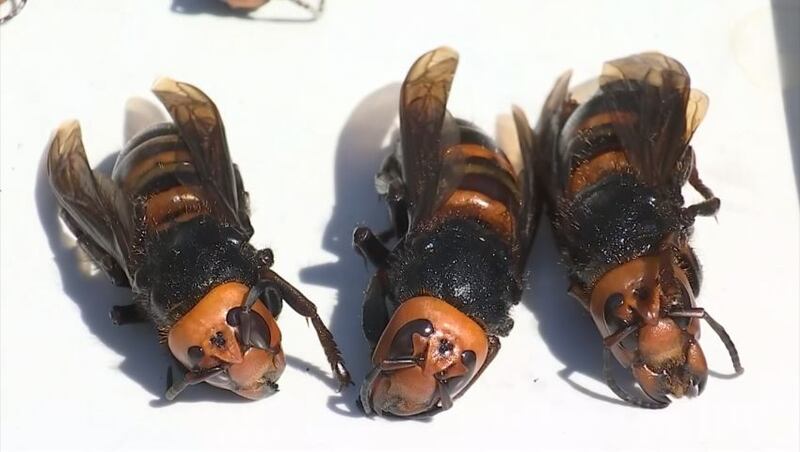PULLMAN, Wash. — Researchers at Washington State University say they have predicted how and where the Asian giant hornet – also dubbed the “murder hornet” -- could spread and find ideal places to live in the US and across the world.
The team found that if the hornet gets a foothold in Washington state, it could spread down much of the West Coast.
>>WSDA confirms state’s first Asian giant hornet sighting this year
The hornet could also find habitat throughout the eastern seaboard and parts of Africa, Australia, Europe and South America if humans accidentally transport it.
Researchers say the predictions emphasize how important it is to stop the large hornets in Washington before they spread.
Scientists from the state Department of Agriculture and WSU entomologists examined hundreds of records from the hornet’s native range in Japan, South Korea and Taiwan, then used a set of ecological models and climate information to predict where it could likely live across six continents.
“We’re making an educated guess on how fast and far these insects can move, their rate of success in establishing a nest, and offering different scenarios, from least bad to worst. No one has done this before for this species,” said WSU entomologist Javier Illan.
>>Giant hornets spell trouble for beekeepers, farmers in Washington state
Experts say the Asian giant hornet is a significant threat to Western honey bees. In late summer and fall, hornet colonies attack beehives, destroying entire colonies.
The hornets are most likely to thrive in places with warm summers, mild winters and a lot of rain. High heat will kill them, so their best habitats are in areas with a high temperature of 102 degrees.
Giant hornets could live along much of the US west and east coasts, adjacent parts of Canada, much of Europe, northwestern and southeastern South America, central Africa, eastern Australia and most parts of New Zealand, WSU said in a news release.
>>An inside look at how Ant-Man tech may solve Washington’s Asian giant hornet problem
The hornet is unable to live in much of the interior of the US because of extreme heat, cold and low rainfall. That includes the eastern parts of Washington and British Columbia, and California’s Central Valley, which have major fruit and nut crops that rely on pollination from honey bees.
Scientists predict that without control, the hornets could spread into southern Washington and Oregon, and north through British Columbia.
More news from KIRO 7
- Body of missing pregnant Parkland woman found; ex-boyfriend arrested
- First presidential debate: What time, what channel, livestream, live updates
- Seattle City Council votes to override Mayor Durkan’s veto of police budget cut
- Do you have an investigative story tip? Send us an email at investigate@kiro7.com
Researchers said their worst-case scenario found that the hornets could spread throughout the western parts of Washington and Oregon in 20 years or less.
But scientists cautioned that the predictions are an educated guess and that people play a role in moving invasive species around the world.
“The information that we want—how fast and far queens can fly, and when they fly—is all unknown,” Illan said. “A lot of basic biology is unknown. So, we’re using a surrogate.”
Though a US Department of Agriculture study found that humans accidentally transporting hornets is unlikely, Washington State Department of Agriculture scientist Chris Looney said that human-assisted spread could be a concern.
“It’s easy for some species to get moved accidentally from one side of the country to the other, even if there’s a large swathe of unacceptable habitat in between,” he said.
Cox Media Group








